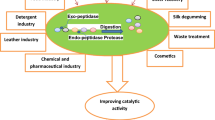Abstract
A moderately thermophilic bacterial strain, Meiothermus ruber H328, can efficiently solubilize intact chicken feathers by aerobic cultivation at 55 °C for 6 days. The keratinolytic proteases extracellularly secreted by the strain were partially purified by an ultrafiltration system and a size-exclusion column chromatography, and thus were found to be two different sizes of macromolecules with an extremely high molecular mass like the sizes of virus and DNA (peak 1 fraction) and with a molecular mass of larger than 500 kDa (peak 2 fraction). They formed protein complex assemblies that were composed of multiple but different proteins. The peak 1 fraction showed more thermophilic characteristics than did the peak 2 fraction in temperature dependence and thermal stability. By contrast, they comparably showed extraordinary resistance to powerful denaturants, SDS at 30 % (w/v) and organic solvents (methanol, ethanol, acetonitrile, acetone, and chloroform) at 40 % (v/v) at 60 °C for 30 min. The extraordinary denaturant tolerance and the large molecular size of the keratinolytic protease complex assemblies suggest the possibility that those may be lipophilic and have the structure of partial membrane fractions, or membrane vesicles, which are exfoliated from the outer membrane of the cells.




Similar content being viewed by others
References
Clouthierab CM, Pelletier JN (2012) Expanding the organic toolbox: a guide to integrating biocatalysis in synthesis. Chem Soc Rev 41:1585–1605
Doukyu N, Ogino H (2010) Organic solvent-tolerant enzymes. Biochem Eng J 48:270–282
Gupta R, Ramnani P (2006) Microbial keratinases and their prospective applications: an overview. Appl Microbiol Biotechnol 70:21–33
Ellis TN, Kuehn MJ (2010) Virulence and immunomodulatory roles of bacterial outer membrane vesicles. Microbiol Mol Biol Rev 74:81–94
Haurat MF, Aduse-Opoku J, Rangarajan M, Dorobantu L, Gray MR, Curtis MA, Feldman MF (2011) Selective sorting of cargo proteins into bacterial membrane vesicles. J Biol Chem 286:1269–1276
Inada S, Watanabe K (2013) Draft genome sequence of Meiothermus ruber H328, which degrades chicken feathers, and identification of proteases and peptidases responsible for degradation. Genome Announc 1:e00176–13
Jaouadi B, Abdelmalek B, Fodil D, Ferradji FD, Rekik H, Zarai N, Bejar S (2010) Purification and characterization of a thermostable keratinolytic serine alkaline proteinase from Streptomyces sp. strain AB1 with high stability in organic solvents. Bioresour Technol 101:8361–8369
Kisselev AF, Akopian TN, Woo KM, Goldberg AL (1999) The sizes of peptides generated from protein by mammalian 26 and 20 S proteasomes. Implications for understanding the degradative mechanism and antigen presentation. J Biol Chem 274:3363–3371
Krystyna W, Lobarzewski J, Wolski T (1987) Intracellular keratinase of Trichophyton gallinae. J Med Vet Mycol 25:261–268
Kumar D, Bhalla TC (2005) Microbial proteases in peptide synthesis: approaches and applications. Appl Microbiol Biotechnol 68:726–736
Kulp A, Kuehn MJ (2010) Biological functions and biogenesis of secreted bacterial outer membrane vesicles. Annu Rev Microbiol 64:163–184
Laemmli UK (1970) Cleavage of structural proteins during the assembly of the head of bacteriophage T4. Nature 227:680–685
Liang X, Bian Y, Tang XF, Xiao G, Tang B (2010) Enhancement of keratinolytic activity of a thermophilic subtilase by improving its autolysis resistance and thermostability under reducing conditions. Appl Microbiol Biotechnol 89:999–1006
Lowry OH, Rosenbrough NJ, Farr AL, Randall RJ (1951) Protein measurement with the Folin phenol reagent. J Biol Chem 193:265–275
Manni L, Jellouli K, Ghorbel-Bellaaj O, Agrebi R, Haddar A, Sellami-Kamoun A, Nasri M (2010) An oxidant- and solvent-stable protease produced by Bacillus cereus SV1:application in the deproteinization of shrimp wastes and as a laundry detergent additive. Appl Biochem Biotechnol 160:2308–2321
Mashburn LM, Whiteley M (2005) Membrane vesicles traffic signals and facilitate group activities in a prokaryote. Nature 437:422–425
Matsui T, Yamada Y, Mitsuya H, Shigeri Y, Yoshida Y, Saito Y, Matsui H, Watanabe K (2009) Sustainable and practical degradation of intact chicken feathers by cultivating a newly isolated thermophilic Meiothermus ruber H328. Appl Microbiol Biotechnol 82:941–950
Maupin-Furlow J (2011) Proteasomes and protein conjugation across domains of life. Nature Rev Microbiol 10:100–111
Nishino T, Nakayama T, Hemmi H, Shimoyama T, Yamashita S, Akai M, Kanagawa T, Hoshi K (2003) Acidulocomposting, an accelerated composting process of garbage under thermoacidophilic conditions for prolonged periods. J Environ Biotech 3:33–36
Okamoto M, Yonejima Y, Tsujimoto Y, Suzuki Y, Watanabe K (2001) A thermostable collagenolytic protease with a very large molecular mass produced by thermophilic Bacillus sp. strain MO-1. Appl Microbiol Biotechnol 57:103–108
Riessen S, Antranikian G (2001) Isolation of Thermoanaerobacter keratinophilus sp. nov., a novel thermophilic, anaerobic bacterium with keratinolytic activity. Extremophiles 5:399–408
Shigeri Y, Matsui T, Watanabe K (2009) Decomposition of intact chicken feathers by a thermophile in combination with an acidulocomposting garbage-treatment process. Biosci Biotechnol Biochem 73:2519–2521
Volker C, Lupas AN (2002) Molecular evolution of proteasomes. Curr Top Microbiol Immunol 268:1–22
Watanabe K (2004) Collagenolytic proteases from bacteria. Appl Microbiol Biotechnol 63:520–526
Wohlgemuth R (2010) Biocatalysis—key to sustainable industrial chemistry. Curr Opin Biotechnol 21:713–724
Acknowledgments
We thank Keishi Nomura for technical supports. This work was in part supported by The Iwatani Naoji Foundation (Tokyo, Japan) and Institute for Fermentation (Osaka, Japan).
Author information
Authors and Affiliations
Corresponding author
Rights and permissions
About this article
Cite this article
Kataoka, M., Yamaoka, A., Kawasaki, K. et al. Extraordinary denaturant tolerance of keratinolytic protease complex assemblies produced by Meiothermus ruber H328. Appl Microbiol Biotechnol 98, 2973–2980 (2014). https://doi.org/10.1007/s00253-013-5155-8
Received:
Revised:
Accepted:
Published:
Issue Date:
DOI: https://doi.org/10.1007/s00253-013-5155-8




